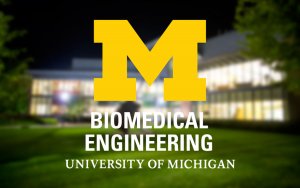Presented By: Biomedical Engineering
Novel Models to Image and Quantify Bone Drug Efficacy and Disease Progression in Vivo: Addressing the Fragility Phenotype
Final Oral Examination - Rachel Surowiec

Bone is a composite biomaterial of mineral crystals, organic matrix, and water. Each contributes to bone quality and strength and may change independently, or together, with disease progression and treatment. Even so, there is a near ubiquitous reliance on ionizing x-ray-based approaches to characterize bone mineral density (BMD) which only accounts for ~60% of bone strength and may not adequately predict fracture risk. In a rare and severe bone disease such as osteogenesis imperfecta (OI), the hallmark genotypic and phenotypic variability makes clinical management particularly challenging. Treatment strategies rely on anti-resorptive bisphosphonates which address osteoclastic, but not osteoblastic deficiencies. Radiographic characterization of efficacy identifies structural, but not biomaterial-level alterations. Together, there is an unmet need for improved treatment strategies and means to longitudinally monitor treatment outcomes at the biomaterial-level to improve clinical management of bone disease.
This thesis will describe a novel model to understand and predict individual patient treatment response to an emerging therapeutic, sclerostin antibody (SclAb) prior to clinical exposure. We then challenge the current bone imaging gold-standard with the characterization of a novel zero echo time (ZTE) magnetic resonance imaging (MRI) technique that may hold promise in identifying matrix-level and biochemical changes characteristic of OI and other diseases.
SclAb has gained interest as a promising bone-forming therapeutic suggesting a novel treatment strategy through inhibition of endogenous sclerostin but effects in human pediatric OI bone remains unknown. We treated bone samples retrieved from pediatric OI patients during surgery with SclAb in vitro and quantified transcriptional response of Wnt-related genes. Results demonstrated a bone-forming response in a manner paralleling pre-clinical experience. Factors inherent to the unique phenotypic/genotypic patient profile such as the patient’s baseline cellular phenotype appear to govern response magnitude; OI patients with low untreated expression of osteoblast-related genes demonstrated the greatest magnitude of upregulation during treatment. To expand findings in vivo, we developed a novel OI xenograft model where bone was implanted into a host-derived microenvironment. The model was efficacious; bone was bioaccessible by the host and retained patient-derived bone cells throughout implantation. Treatment increased bone density and volume with a variable outcome between cortical and trabecular bone. Patients with low baseline osterix demonstrated robust human-derived osterix-expression with treatment supporting in vitro findings. The validated xenograft model can be used to establish patient-specific factors influencing treatment response suggesting a personalized medicine approach to managing OI.
Characterization of treatment efficacy for OI, as well as other metabolic bone diseases, is complicated by the lack of imaging modality able to safely monitor material-level and biochemical changes in vivo. To improve upon BMD, we tested the efficacy of a 3D ZTE-MRI approach in an estrogen-deficient (OVX) model of osteoporosis during growth. ZTE-MRI-derived BMD correlated significantly with BMD measured using the gold standard, µCT, which significantly increased longitudinally over the duration of the study. Growth appeared to overcome estrogen-deficient changes in bone mass yet ZTE-MRI detected significant changes consistent with estrogen deficiency by ten weeks in cortical water, cortical matrix organization (T1) and marrow fat. Findings point to ZTE-MRI’s ability to quantify BMD in good agreement with the gold standard and detect biochemical alterations consistent with disease independent of the mineral phase suggesting its value for bone imaging. Together, results from this thesis indicate a new treatment design and non-ionizing imaging strategy to improve management of bone diseases such as OI.
Chair: Kenneth Kozloff
This thesis will describe a novel model to understand and predict individual patient treatment response to an emerging therapeutic, sclerostin antibody (SclAb) prior to clinical exposure. We then challenge the current bone imaging gold-standard with the characterization of a novel zero echo time (ZTE) magnetic resonance imaging (MRI) technique that may hold promise in identifying matrix-level and biochemical changes characteristic of OI and other diseases.
SclAb has gained interest as a promising bone-forming therapeutic suggesting a novel treatment strategy through inhibition of endogenous sclerostin but effects in human pediatric OI bone remains unknown. We treated bone samples retrieved from pediatric OI patients during surgery with SclAb in vitro and quantified transcriptional response of Wnt-related genes. Results demonstrated a bone-forming response in a manner paralleling pre-clinical experience. Factors inherent to the unique phenotypic/genotypic patient profile such as the patient’s baseline cellular phenotype appear to govern response magnitude; OI patients with low untreated expression of osteoblast-related genes demonstrated the greatest magnitude of upregulation during treatment. To expand findings in vivo, we developed a novel OI xenograft model where bone was implanted into a host-derived microenvironment. The model was efficacious; bone was bioaccessible by the host and retained patient-derived bone cells throughout implantation. Treatment increased bone density and volume with a variable outcome between cortical and trabecular bone. Patients with low baseline osterix demonstrated robust human-derived osterix-expression with treatment supporting in vitro findings. The validated xenograft model can be used to establish patient-specific factors influencing treatment response suggesting a personalized medicine approach to managing OI.
Characterization of treatment efficacy for OI, as well as other metabolic bone diseases, is complicated by the lack of imaging modality able to safely monitor material-level and biochemical changes in vivo. To improve upon BMD, we tested the efficacy of a 3D ZTE-MRI approach in an estrogen-deficient (OVX) model of osteoporosis during growth. ZTE-MRI-derived BMD correlated significantly with BMD measured using the gold standard, µCT, which significantly increased longitudinally over the duration of the study. Growth appeared to overcome estrogen-deficient changes in bone mass yet ZTE-MRI detected significant changes consistent with estrogen deficiency by ten weeks in cortical water, cortical matrix organization (T1) and marrow fat. Findings point to ZTE-MRI’s ability to quantify BMD in good agreement with the gold standard and detect biochemical alterations consistent with disease independent of the mineral phase suggesting its value for bone imaging. Together, results from this thesis indicate a new treatment design and non-ionizing imaging strategy to improve management of bone diseases such as OI.
Chair: Kenneth Kozloff